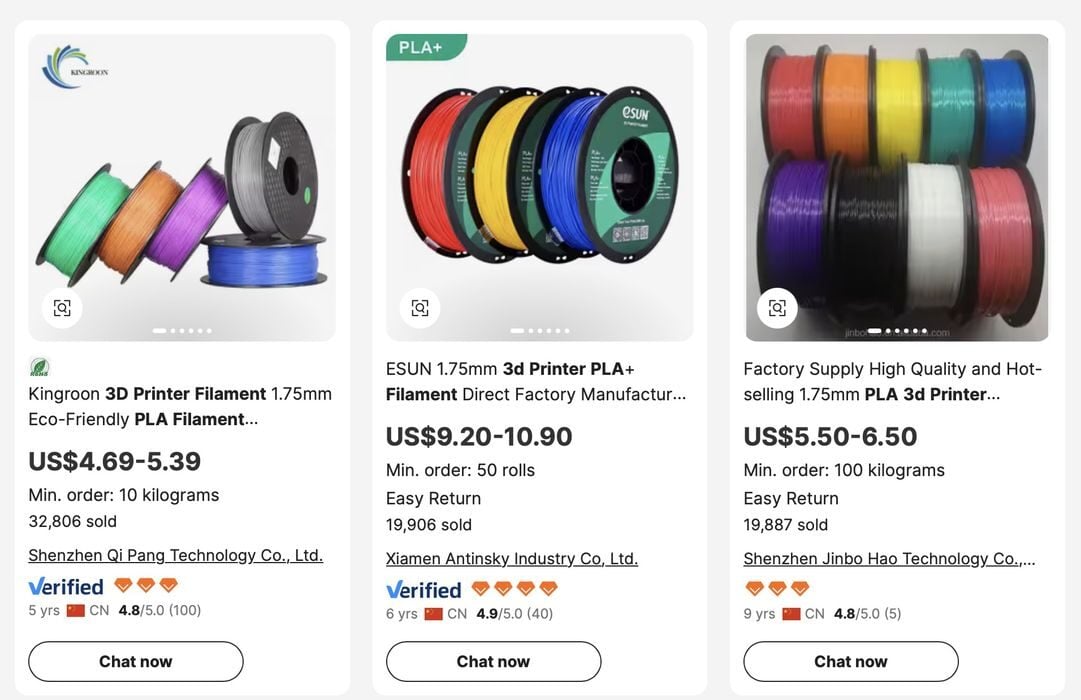
What is the price of filament these days? I’m seeing conflicting information.
If you operate a FFF 3D printer, you will be buying spools of filament. Pricing today for 1kg spools tends to be around these values:
- Prusament PLA: US$29.99
- Polymaker PLA: US$20.99
- Overture PLA: US$24.99
- eSun PLA: US$17.99
That’s quite a range, but there are also shipping costs that can be added on top. Other popular filament providers have similar prices.
However, this week I received a notice from an Asian company looking to sell me filament at only US$5 per kg. Their price for “exotic” ABS-CF material was only US$12.50 per kg. That’s quite a bit lower than the more visible providers.
I decided to investigate further and turned to Alibaba, the B2B service that connects Asian manufacturers to buyers worldwide.
Searching for PLA filament, I found countless providers. Among them were a number of very familiar names, like Kingroon, eSun, SUNLU, and even Polymaker. There were also many providers I’d never heard of.
The trick to lower prices is usually volume purchases. Each of the Alibaba providers specifies a minimum quantity per purchase, and there’s an unknown shipping cost as well. Here’s some typical pricing:
| PRODUCT | AVG PRICE | MIN. QTY (KGs) |
| Kingroon PLA | $5.04 | 10 |
| eSun | $10.05 | 50 |
| SUNLU | $6.79 | 5 |
| Polymaker | $10.71 | 50 |
| Generic | $6.00 | 100 |
| Generic | $5.40 | 1 |
| Generic | $3.73 | 1 |
| YOUSU | $11.50 | 30 |
| Generic | $7.20 | 1 |
| JIXIN | $4.99 | 20 |
| Prospect | $7.00 | 1 |
As you can see, the prices and quantities are all over the place, but in general they are vastly less than the typical pricing seen by Western 3D printer operators.
The generic providers tend to have even lower price points, some only 20% of the regular providers. Imagine getting a 1kg spool of reasonable filament for only US$5!
But is this really true? There are some concerns.
First, there’s the risk. Is this really filament from [name brand]? Or is the vendor just saying that and substituting a generic brand instead?
Is the vendor even going to deliver the product at all? I’ve had cases where I’ve paid for products on AliExpress that I never saw arrive.
Then there’s the shipping cost. This is typically not included in the pricing, but is still part of the transaction. That’s where this can break down. Shipping a 1kg item across the ocean can be pricey, and would notably affect the total cost of the transaction.
This is where the volume discount comes in. Shipping a collection of spools is more expensive in total, but typically less expensive per spool.
This is what Western distributors do: they buy a huge amount of product, ship it all over at once, and then the cost per spool for shipping is pretty low.
In the end, the decision depends on the situation. If you just want a single spool of something, it may not be worth the shipping cost and risk.
A way to mitigate that risk would be to do a “test purchase” of a smaller amount to verify the validity of the provider and the quality of the product. If that worked out, then a larger bulk order could be done later.
If you are using a large amount of filament, then this might be the best way to save on material costs. If you are a small operation, then an approach might be to collect a group of friends together and make a bulk purchase. The shipping costs would be spread across everyone, and a pretty low cost per spool could be achieved.
All of this requires one to take a different lane in purchasing 3D printer filament, and not everyone will be comfortable with that. But for the others, it’s a way to reduce your 3D printing costs.
Via Alibaba
